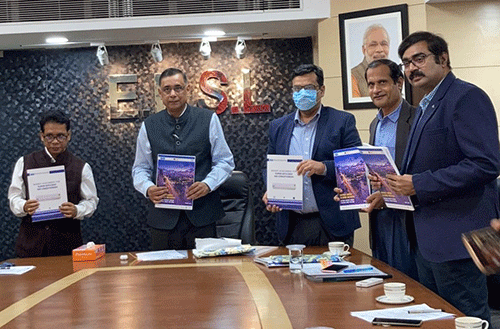EESL reports reinforce theobjectives of India Cooling Action Plan; Says District Cooling System andenergy efficient ACs can be the enablers of India’s cooling revolution.

EESL launches market assessment study for super-efficient ACs; alsolaunches a National District Cooling potential study for India.
-
27 million tons of CO2 emissions could be mitigated annuallyby using District Cooling System (DCS) with strong policy push.
-
DCS can be aninnovative model to address the deteriorating climate situation.
Energy Efficiency ServicesLimited, (EESL), a joint venture under the Ministry of Power, Government ofIndia, with support from Global Environment Facility (GEF) and UN EnvironmentProgramme (UNEP) launched a market assessment study for Super-Efficient ACs. Areport on District Cooling Potential in India was also launched incollaboration with UNEP, GEF, District Energy in Cities initiatives, EMPOWEREnergy Solutions, and Copenhagen Centre on Energy Efficiency with PwC as aknowledge partner.
Both the studies explore the adoptionof efficient and climate-friendly technologies for the urban cooling and RoomAir-Conditioning (RAC) sector, which can potentially reduce the energyrequirements and environmental impacts associated with their use. These studiesare an attempt to augment the objective of India Cooling Action Plan (ICAP).
India is the second fastest growing economy inthe world. Increasing income levels, urbanization and rising temperatures haveled to a growth in demand for room air-conditioners (RACs). The marketassessment study for Super-Efficient ACs provides a comprehensive overview oftrends in Indian and global RAC market and analyses RAC component pricing, financingmechanisms, business models, and ‘go to’ market strategies to scale up thedeployment of Super-Efficient Air Conditioner (SEAC) program in India.
The national cooling demand forspace cooling in new commercial buildings or similar lies in the range of 110million Tonnes of Refrigeration (TR) by year 2037-38. The district coolingstudy estimates that by 2038, approximately 51 million TR of the national spacecooling demand could theoretically connect to district cooling systems. If thislevel of demand were served by district cooling, it would reduce the need forup to 22GW of power capacity and reduce 27 million tonnes of CO2emissions annually.
However, very strong policiesand regulatory mechanisms would be required to trigger such market developmentand the study projects a more realistic scenario that 13 million TR isestablished by 2038 albeit still with significant policy support.
Ms. Geeta Menon, JointSecretary, Ministry of Environment, Forests, and Climate Change, Government ofIndia, said, “As one of the first nations to release a cooling action plan,India has been early to acknowledge the role of cross-sectoral policies andtechnologies to address rising need for cooling. The cooling demand of citizensand institutions alike must be considered, in depth, to identify solutions thatnot only ensure low-emission, low-carbon solutions, but also enable coolingaccess for all.”
Attending the virtual event,Atul Bagai, Head, India Country Office, United Nations Environment Programme(UNEP) said, “Through UNEP-led District Energy in Cities Initiative, we have acommunity of countries, cities, and industry providing necessary support andguidance to cities, states, and national ministries in developing pilotDistrict Cooling and tri-generation projects and supporting the development ofconducive policy, institutional and regulatory frameworks in India.”
With the country’s growth, thedemand for cooling has also rapidly increased. The ‘National District Cooling potential study for India’ undertakesa detailed exercise of estimating India’s future space cooling demand and howmuch of that space cooling demand can be tapped by district cooling systems inIndia’s largest cities. The report also indicates District Cooling System (DCS)as a proven technological solution, which has already been working in differentcities worldwide.
DCS contributes as a driver ofurban sustainability, particularly when considered during the urban planningstage, and enables to integration of local, renewable and waste energy sources.A steering committee for development of DCS in India have also been constitutedby the Bureau of Energy Efficiency (BEE) and Ministry of Environment, Forestand Climate Change (MoEFCC) to which EESL has been appointed as the convener.
Abhay Bakre, Director General,Bureau of Energy Efficiency (BEE), said, “As a globally benchmarked coolingsolution that has been proven in cities across the world, District Cooling canenable efficient and affordable access to cooling for India's citizens. Whileour Star Labelling Programme has created demand for efficient coolingsolutions, the government's ‘District Cooling Action in India’ can play a vitalrole in delivering cooling at a suitable scale to the underserved acrossIndia’s largest cities.”
India currently has singleownership central cooling and ventilation plants, wherein completely privatebusiness models have been adopted. Given the current situation, hybridownership, which has the option of transferring the risk away from a singleparty, has the potential in addressing thetechnical, financial, and capacity related barriers associated with DCSimplementation and can deliver better risk sharing between private and publicsector. Hybrid business models with an emphasis on PPPs and joint venturesshould be prioritised and tested in the Indian context and could benefit fromspecial power and water tariffs, financing options for district cooling servicecompanies, and should have involvement of expert contracting firms for varioustypes of contracts and structuring.
Saurabh Kumar, Executive ViceChairperson (EVC), EESL Group, said, “When effectively unlocked, India'simmense latent demand for sustainable cooling solutions can trigger a virtuouscycle. With the rising scale of India’s demand for cooling, bringing downcooling-related emissions can greatly reduce its climatic impact, andcontribute to reducing global warming, just one of the many significantco-benefits that can be realised.”
Speaking at the event, RajatSud, Managing Director, EESL said, “Cooling represents for EESL the largestpotential in energy efficiency savings, and these two studies are seminal inestablishing policies, programmes, and business model which can take thisforward. In the RAC space, we have firmly established the Super Efficient AC,which has 20 per cent higher efficiency than 5-star rated ACs. It is opportunethat the study is being launched while we enrol private sales agents forpromoting sales of these ACs at the same price as 5-star ACs.”
The situation demands for anintegrated policy framework for promoting district cooling and stronggovernment engagement. It is important to consider special power tariffs topromote thermal storage, DCS expansion and residential connection. Establishmentand standardization of project development process, business models andcontracting can be taken into consideration.